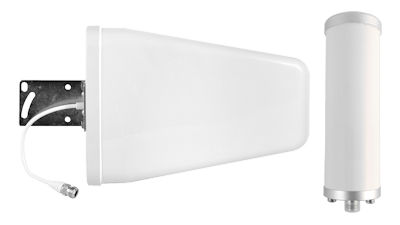Knowledge Base
Should I use a directional or omnidirectional outside antenna?
 A directional LPDA antenna (left) and an omnidirectional cylinder antenna (right)
A directional LPDA antenna (left) and an omnidirectional cylinder antenna (right)
To send and receive signals to the cell tower, a cell phone signal booster requires an outside antenna (called a donor antenna).
A directional antenna needs to be pointed at the cell tower you wish to communicate with. Directional antennas usually have superior gain and signal-to-noise characteristics, but they need to be tuned (adjusted until they’re receiving the best possible signal).
An omnidirectional (or omni) antenna can communicate with multiple towers in any direction. Omni antennas are easier to set up because they don’t have to be tuned.
Use a directional antenna when…
- You have a reasonably clear line of sight from the antenna to the cell tower(s) and all towers you need to communicate with are off in the same direction, or
- A nearby tower you don’t want to use is overpowering your booster and you only want signal from a specific tower that’s farther way in a different direction, or
- You’ve tried an omni antenna and you need more gain and/or less noise.
Use an omni antenna when…
- You need to acquire signal for two or more carriers and their towers are off in different directions, or
- You’re in a remote area with mountains or dense forests, and the weak outside signal is reflecting off of natural objects, or
- You’re in an urban/city environment, where the strong outside signal is reflecting off of buildings, or
- You want an antenna that’s easy to set up and doesn’t require tuning in on a specific tower.

